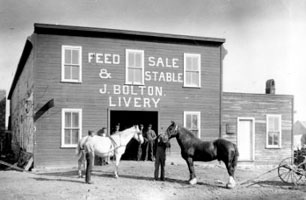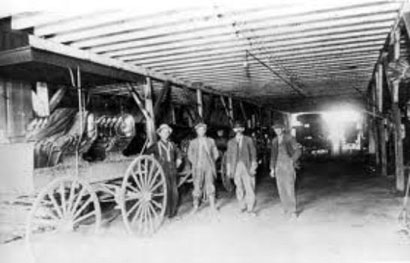|
WILLIAM
AND ANGUS MCDONALD loved horses and saw in the livery business a
profitable venture. In 1893 William closed his blacksmith shop and,
with Angus, bought the livery stable on the main street from Hotham and
Blair. While Angus ran the livery stable, William made frequent trips
to Ontario to purchase horses for sale to the famers, as they changed
from oxen to horses for their farm work. On one such trip in 1900 he
married Jean Murray of Lucknow. They built a brick house on the corner
of West Railway and John Street. There their one son Murray was born.
The family lived there until after William’s death in 1944.
William continued to operate the livery stable until horse and buggy
transportation gave place to the automobile. Seeing the inevitable
decline in the livery business and the need for gasoline and oil to
supply the motor cars and tractors, he secured the Imperial Oil agency
in 1910 and operated that expanding business while still serving the
few who continued to use the horse and buggy.
Both William and Angus were interested in community affairs. William
was a member of the first town council, was mayor in 1910 and served as
councillor for several years thereafter. He was an active member of the
executive and board of directors of the Agricultural Society. Angus was
councillor for the Municipality of Cameron from 1909 to 1912 and in
1912 was elected reeve and served for several years. After he retired
in 1938 he served on the Hartney town council for three years. During
that time he was the councillor in charge of the care of the cemetery
and took a keen delight in planting a lilac hedge and flowers to
beautify the resting places of so many of the friends with whom he had
worked in the past in building the Hartney community.
Adapted from The Mere
Living, page 103.

A typical Manitoba livery stable.
The
Livery Stable
The livery stable was a vital business in any community, and in Hartney
there were several.
It was at the stable where horse teams and wagons were for hire, as
well as buggies, carriages and saddle horses. Most livery stables also
allowed privately-owned horses to be boarded there for a short time. .
Horses were boarded by the day, week or month and cared for by
experienced hostlers. Stables were also sources of hay, grain, coal and
wood. The downside of a livery stable was the smell, especially on a
main street. That is an interesting aspect of heritage conservation
that the typical smells of a town at the turn of the 20th century,
especially with all the horses, cannot be fathomed.

Interior view of a livery stable.
|





